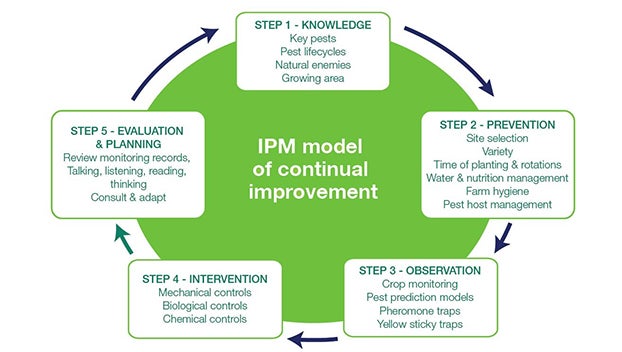MASTER GARDENER — Integrated pest management defined; here’s how it helps you
Published 12:02 am Wednesday, April 19, 2023
|
Getting your Trinity Audio player ready...
|
Using the integrated pest management approach to diminish garden pests is a multiple step, continual improvement model that begins by understanding the pest’s life cycle and characteristics before attempting to develop a control strategy.
Gardeners, today’s discussion is defining Integrated Pest Management, which is a comprehensive approach to managing garden pests which include pathogens, insects, nematodes, mites, weeds and numerous other pests utilizing science-based practices and techniques.
While researching this topic, I reviewed the US Environmental Protection Agency’s website, and according to the USEPA, “Integrated Pest Management is an effective and environmentally sensitive approach to pest management that relies on a combination of common-sense practices.” They further state “IPM programs use current, comprehensive information on the life cycles of pests and their interaction with the environment.”
Utilizing this information, in combination with available pest control methods, is how to manage pest damage cost-effectively, reducing hazards posed to people, property and the environment.
Gardeners, my takeaway from the USEPA’s website is the IPM approach can be applied to agricultural and non-agricultural settings, i.e., home gardens. IPM is an all-inclusive management strategy that takes advantage of appropriate pest management options including, though not limited to, the cautious use of pesticides.
Readers a side note here as this contrasts with organic food production which applies numerous similar concepts as IPM yet limits the use of pesticides, to those which are produced from natural sources, versus synthetic chemicals.
These techniques are implemented throughout the entire growth cycle and production period of flowers and vegetable crops.
Integrated is the key word, focusing on a combined, cohesive approach that combines a variety of pest management techniques and practices.
IPM practices were developed to prevent and eradicate pests by reducing their populations cost effectively, in an environmentally friendly manner while maintaining plant quality. Most all IPM systems include preventative methods utilizing appropriate sanitation that includes weed control, removal of plant debris and disinfecting garden tools.
Additional practices include fertilization, irrigation, and pruning. Supplemental practices, such as the introduction of beneficial insects, are employed specifically to manage existing pest problems.
The management portion of IPM centers around activities that affect pests and diseases encompassing a broad range of measures that can include the application of biological control agents to preserve beneficial organisms while reducing environmental impact through contamination.
How do IPM Programs Work?
It’s important to note IPM is not an individual method of control but a series of pest management evaluations, decisions, and controls. Gardeners and growers practicing IPM are aware of the potential for pest infestation follow a hierarchical or tiered approach, which include four steps:
Predetermined Minimum Action Thresholds – a point at which pest populations or environmental conditions indicate that pest control is necessary. Initial detection of a single pest does not always mean control is needed.
Identify Pests and Monitor – remember not all insects, weeds, and other pests require control, since many are harmless and often beneficial. IPM programs work by monitoring and accurately identifying pests before exercising control decisions, which are made in conjunction with predetermined action thresholds, so know your foe!
Deterrence – for vegetable gardens, crop rotation will always be the first line of defense for your IPM strategy to prevent pests from becoming a threat. Rotating between different crops, choosing pest-resistant varieties, and planting pest-free rootstock are very effective control methods that are cost-efficient, posing no risk to people or the environment.
Control – once the preceding approaches are exhausted, indicating pest control is warranted as preventive methods are not effective, evaluate the proper control method both for effectiveness and risk. Effective, yet less risky pest controls are initially selected, these include highly targeted chemicals, such as pheromones to disrupt pest mating, or mechanical control, such as trapping, weeding, or simply using your fingers to ‘pluck’ the critters from plants and destroying them!
If further monitoring, identification, and action thresholds indicate less invasive controls are not adequate, the use of more targeted pest control methods can be exercised, such as targeted spraying of pesticides, the absolute last resort would be broadcast spraying of non-specific pesticides, which kills all pests indiscriminately, even beneficial insects!
IPM is best described as a continuum and many gardeners identify their pests before determining the best course of action to reduce and manage pests. Every gardener’s goal should be to move further along the IPM continuum by using all appropriate stepped IPM techniques.
The principles stated above are used by commercial growers and large farms but can also be applied to your own garden by following the four-tiered approach outlined above. F
or more specific information on practicing IPM in your garden, you can contact your local state Extension Services for the services of a Master Gardener. So long for now fellow gardeners, let’s go out and grow ourselves a greener, more ‘pest-free’ world, one plant at a time.
John Green is Texas Certified Master Gardener with Orange County Master Gardeners. To have gardening questions answered in detail, contact him at jongreene57@gmail.com, reach out to Orange County Master Gardeners Helpline at 409-882-7010 or visit https://txmg.org/orange, Facebook: Orange County Texas Master Gardeners Association or by email extension@co.orange.tx.us.






